Weiming Ren
Vamba: Understanding Hour-Long Videos with Hybrid Mamba-Transformers
Mar 14, 2025Abstract:State-of-the-art transformer-based large multimodal models (LMMs) struggle to handle hour-long video inputs due to the quadratic complexity of the causal self-attention operations, leading to high computational costs during training and inference. Existing token compression-based methods reduce the number of video tokens but often incur information loss and remain inefficient for extremely long sequences. In this paper, we explore an orthogonal direction to build a hybrid Mamba-Transformer model (VAMBA) that employs Mamba-2 blocks to encode video tokens with linear complexity. Without any token reduction, VAMBA can encode more than 1024 frames (640$\times$360) on a single GPU, while transformer-based models can only encode 256 frames. On long video input, VAMBA achieves at least 50% reduction in GPU memory usage during training and inference, and nearly doubles the speed per training step compared to transformer-based LMMs. Our experimental results demonstrate that VAMBA improves accuracy by 4.3% on the challenging hour-long video understanding benchmark LVBench over prior efficient video LMMs, and maintains strong performance on a broad spectrum of long and short video understanding tasks.
VISTA: Enhancing Long-Duration and High-Resolution Video Understanding by Video Spatiotemporal Augmentation
Dec 01, 2024



Abstract:Current large multimodal models (LMMs) face significant challenges in processing and comprehending long-duration or high-resolution videos, which is mainly due to the lack of high-quality datasets. To address this issue from a data-centric perspective, we propose VISTA, a simple yet effective Video Spatiotemporal Augmentation framework that synthesizes long-duration and high-resolution video instruction-following pairs from existing video-caption datasets. VISTA spatially and temporally combines videos to create new synthetic videos with extended durations and enhanced resolutions, and subsequently produces question-answer pairs pertaining to these newly synthesized videos. Based on this paradigm, we develop seven video augmentation methods and curate VISTA-400K, a video instruction-following dataset aimed at enhancing long-duration and high-resolution video understanding. Finetuning various video LMMs on our data resulted in an average improvement of 3.3% across four challenging benchmarks for long-video understanding. Furthermore, we introduce the first comprehensive high-resolution video understanding benchmark HRVideoBench, on which our finetuned models achieve a 6.5% performance gain. These results highlight the effectiveness of our framework.
OmniEdit: Building Image Editing Generalist Models Through Specialist Supervision
Nov 11, 2024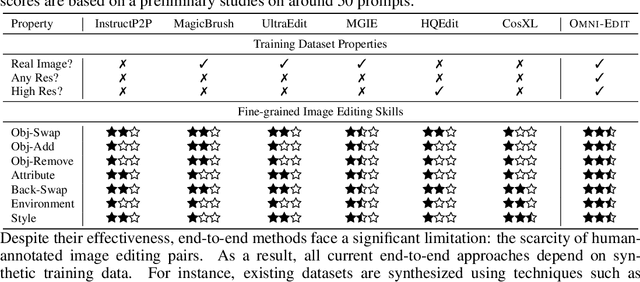
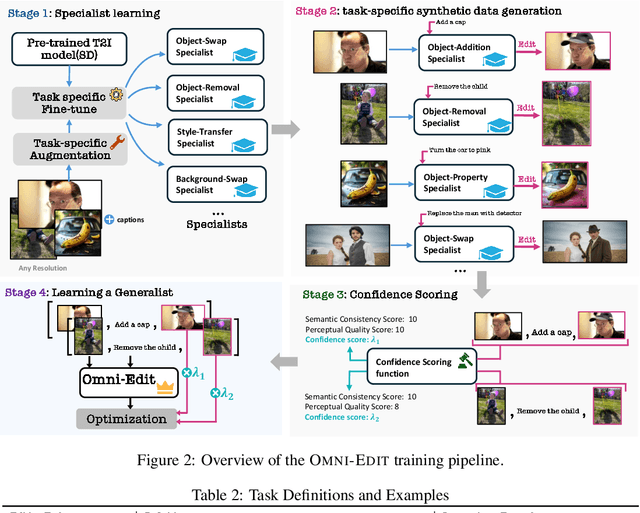
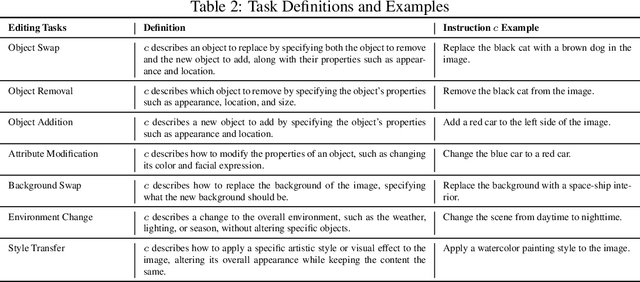
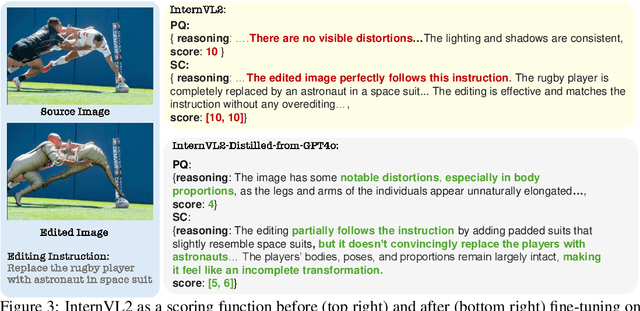
Abstract:Instruction-guided image editing methods have demonstrated significant potential by training diffusion models on automatically synthesized or manually annotated image editing pairs. However, these methods remain far from practical, real-life applications. We identify three primary challenges contributing to this gap. Firstly, existing models have limited editing skills due to the biased synthesis process. Secondly, these methods are trained with datasets with a high volume of noise and artifacts. This is due to the application of simple filtering methods like CLIP-score. Thirdly, all these datasets are restricted to a single low resolution and fixed aspect ratio, limiting the versatility to handle real-world use cases. In this paper, we present \omniedit, which is an omnipotent editor to handle seven different image editing tasks with any aspect ratio seamlessly. Our contribution is in four folds: (1) \omniedit is trained by utilizing the supervision from seven different specialist models to ensure task coverage. (2) we utilize importance sampling based on the scores provided by large multimodal models (like GPT-4o) instead of CLIP-score to improve the data quality. (3) we propose a new editing architecture called EditNet to greatly boost the editing success rate, (4) we provide images with different aspect ratios to ensure that our model can handle any image in the wild. We have curated a test set containing images of different aspect ratios, accompanied by diverse instructions to cover different tasks. Both automatic evaluation and human evaluations demonstrate that \omniedit can significantly outperform all the existing models. Our code, dataset and model will be available at \url{https://tiger-ai-lab.github.io/OmniEdit/}
MMLU-Pro: A More Robust and Challenging Multi-Task Language Understanding Benchmark
Jun 04, 2024



Abstract:In the age of large-scale language models, benchmarks like the Massive Multitask Language Understanding (MMLU) have been pivotal in pushing the boundaries of what AI can achieve in language comprehension and reasoning across diverse domains. However, as models continue to improve, their performance on these benchmarks has begun to plateau, making it increasingly difficult to discern differences in model capabilities. This paper introduces MMLU-Pro, an enhanced dataset designed to extend the mostly knowledge-driven MMLU benchmark by integrating more challenging, reasoning-focused questions and expanding the choice set from four to ten options. Additionally, MMLU-Pro eliminates the trivial and noisy questions in MMLU. Our experimental results show that MMLU-Pro not only raises the challenge, causing a significant drop in accuracy by 16% to 33% compared to MMLU but also demonstrates greater stability under varying prompts. With 24 different prompt styles tested, the sensitivity of model scores to prompt variations decreased from 4-5% in MMLU to just 2% in MMLU-Pro. Additionally, we found that models utilizing Chain of Thought (CoT) reasoning achieved better performance on MMLU-Pro compared to direct answering, which is in stark contrast to the findings on the original MMLU, indicating that MMLU-Pro includes more complex reasoning questions. Our assessments confirm that MMLU-Pro is a more discriminative benchmark to better track progress in the field.
Video Diffusion Models: A Survey
May 06, 2024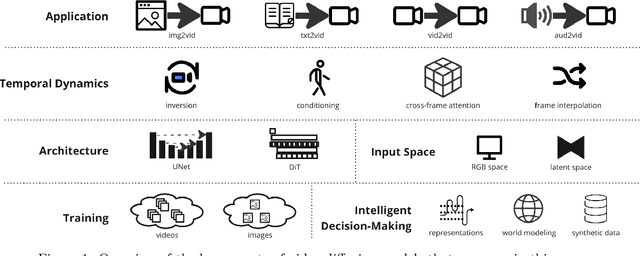

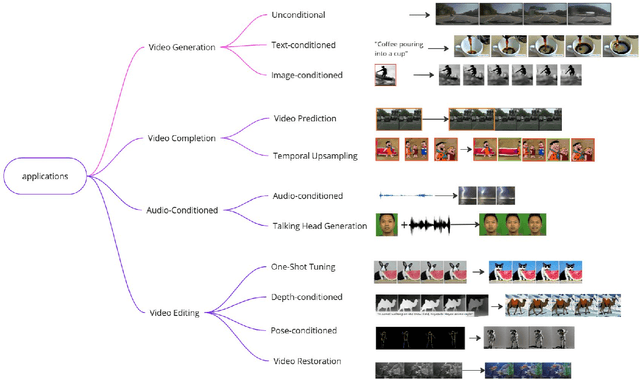

Abstract:Diffusion generative models have recently become a robust technique for producing and modifying coherent, high-quality video. This survey offers a systematic overview of critical elements of diffusion models for video generation, covering applications, architectural choices, and the modeling of temporal dynamics. Recent advancements in the field are summarized and grouped into development trends. The survey concludes with an overview of remaining challenges and an outlook on the future of the field. Website: https://github.com/ndrwmlnk/Awesome-Video-Diffusion-Models
AnyV2V: A Plug-and-Play Framework For Any Video-to-Video Editing Tasks
Mar 22, 2024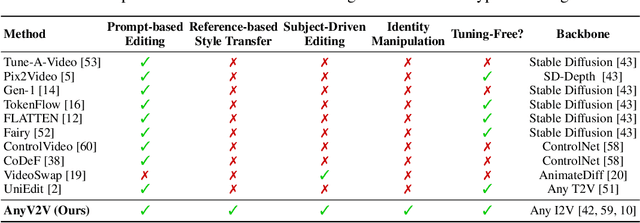
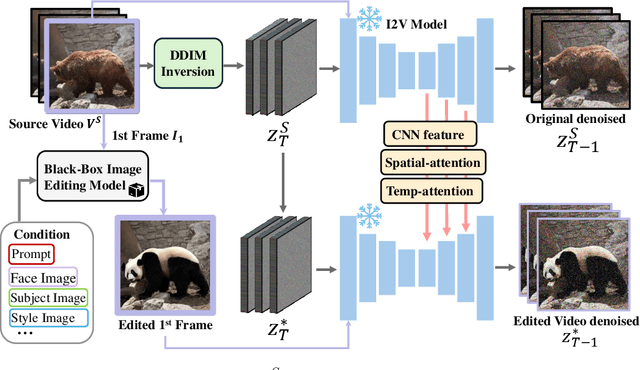
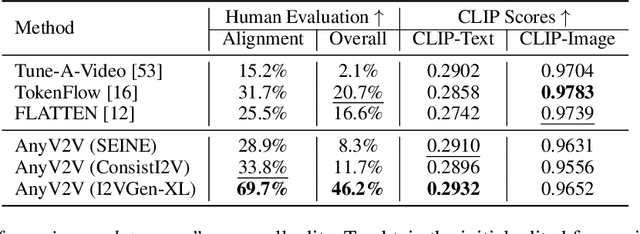
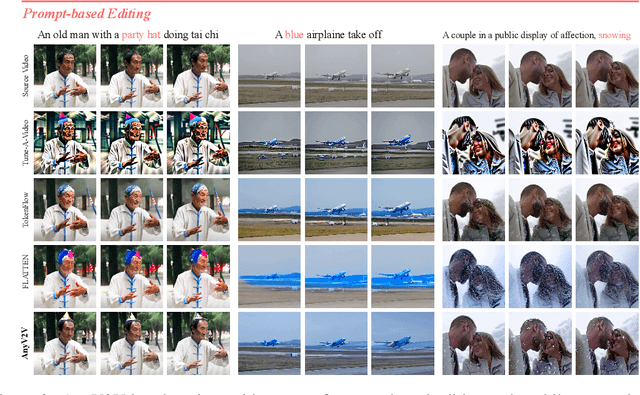
Abstract:Video-to-video editing involves editing a source video along with additional control (such as text prompts, subjects, or styles) to generate a new video that aligns with the source video and the provided control. Traditional methods have been constrained to certain editing types, limiting their ability to meet the wide range of user demands. In this paper, we introduce AnyV2V, a novel training-free framework designed to simplify video editing into two primary steps: (1) employing an off-the-shelf image editing model (e.g. InstructPix2Pix, InstantID, etc) to modify the first frame, (2) utilizing an existing image-to-video generation model (e.g. I2VGen-XL) for DDIM inversion and feature injection. In the first stage, AnyV2V can plug in any existing image editing tools to support an extensive array of video editing tasks. Beyond the traditional prompt-based editing methods, AnyV2V also can support novel video editing tasks, including reference-based style transfer, subject-driven editing, and identity manipulation, which were unattainable by previous methods. In the second stage, AnyV2V can plug in any existing image-to-video models to perform DDIM inversion and intermediate feature injection to maintain the appearance and motion consistency with the source video. On the prompt-based editing, we show that AnyV2V can outperform the previous best approach by 35\% on prompt alignment, and 25\% on human preference. On the three novel tasks, we show that AnyV2V also achieves a high success rate. We believe AnyV2V will continue to thrive due to its ability to seamlessly integrate the fast-evolving image editing methods. Such compatibility can help AnyV2V to increase its versatility to cater to diverse user demands.
StructLM: Towards Building Generalist Models for Structured Knowledge Grounding
Feb 28, 2024Abstract:Structured data sources, such as tables, graphs, and databases, are ubiquitous knowledge sources. Despite the demonstrated capabilities of large language models (LLMs) on plain text, their proficiency in interpreting and utilizing structured data remains limited. Our investigation reveals a notable deficiency in LLMs' ability to process structured data, e.g., ChatGPT lags behind state-of-the-art (SoTA) model by an average of 35%. To augment the Structured Knowledge Grounding (SKG) capabilities in LLMs, we have developed a comprehensive instruction tuning dataset comprising 1.1 million examples. Utilizing this dataset, we train a series of models, referred to as StructLM, based on the Code-LLaMA architecture, ranging from 7B to 34B parameters. Our StructLM series surpasses task-specific models on 14 out of 18 evaluated datasets and establishes new SoTA achievements on 7 SKG tasks. Furthermore, StructLM demonstrates exceptional generalization across 6 novel SKG tasks. Contrary to expectations, we observe that scaling model size offers marginal benefits, with StructLM-34B showing only slight improvements over StructLM-7B. This suggests that structured knowledge grounding is still a challenging task and requires more innovative design to push to a new level.
ConsistI2V: Enhancing Visual Consistency for Image-to-Video Generation
Feb 06, 2024Abstract:Image-to-video (I2V) generation aims to use the initial frame (alongside a text prompt) to create a video sequence. A grand challenge in I2V generation is to maintain visual consistency throughout the video: existing methods often struggle to preserve the integrity of the subject, background, and style from the first frame, as well as ensure a fluid and logical progression within the video narrative. To mitigate these issues, we propose ConsistI2V, a diffusion-based method to enhance visual consistency for I2V generation. Specifically, we introduce (1) spatiotemporal attention over the first frame to maintain spatial and motion consistency, (2) noise initialization from the low-frequency band of the first frame to enhance layout consistency. These two approaches enable ConsistI2V to generate highly consistent videos. We also extend the proposed approaches to show their potential to improve consistency in auto-regressive long video generation and camera motion control. To verify the effectiveness of our method, we propose I2V-Bench, a comprehensive evaluation benchmark for I2V generation. Our automatic and human evaluation results demonstrate the superiority of ConsistI2V over existing methods.
MMMU: A Massive Multi-discipline Multimodal Understanding and Reasoning Benchmark for Expert AGI
Nov 27, 2023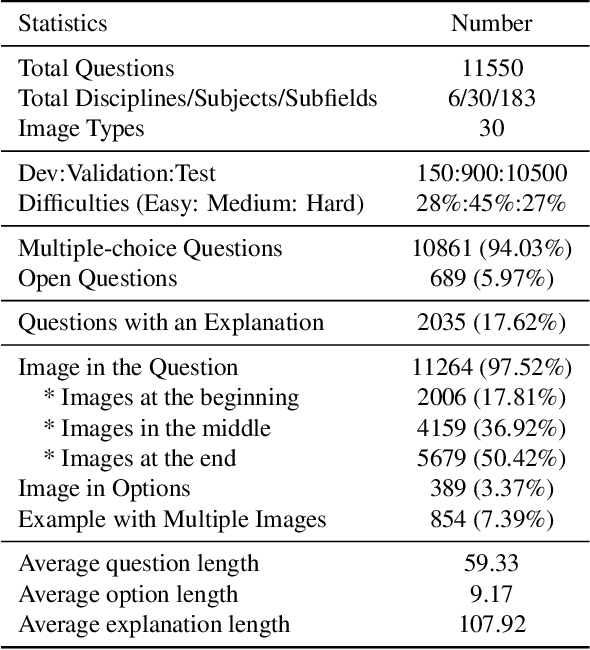
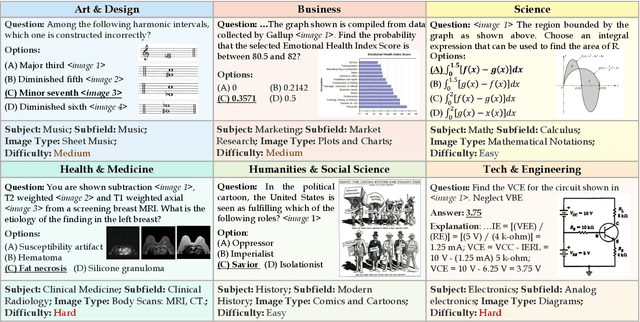
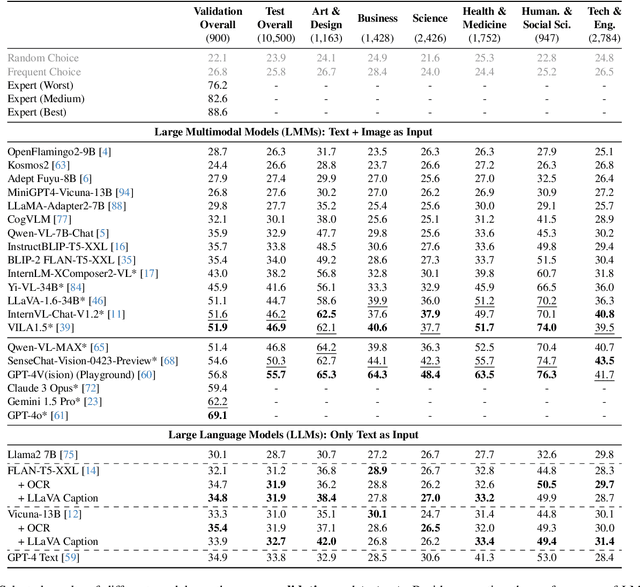

Abstract:We introduce MMMU: a new benchmark designed to evaluate multimodal models on massive multi-discipline tasks demanding college-level subject knowledge and deliberate reasoning. MMMU includes 11.5K meticulously collected multimodal questions from college exams, quizzes, and textbooks, covering six core disciplines: Art & Design, Business, Science, Health & Medicine, Humanities & Social Science, and Tech & Engineering. These questions span 30 subjects and 183 subfields, comprising 30 highly heterogeneous image types, such as charts, diagrams, maps, tables, music sheets, and chemical structures. Unlike existing benchmarks, MMMU focuses on advanced perception and reasoning with domain-specific knowledge, challenging models to perform tasks akin to those faced by experts. Our evaluation of 14 open-source LMMs and the proprietary GPT-4V(ision) highlights the substantial challenges posed by MMMU. Even the advanced GPT-4V only achieves a 56% accuracy, indicating significant room for improvement. We believe MMMU will stimulate the community to build next-generation multimodal foundation models towards expert artificial general intelligence.
HiCu: Leveraging Hierarchy for Curriculum Learning in Automated ICD Coding
Aug 03, 2022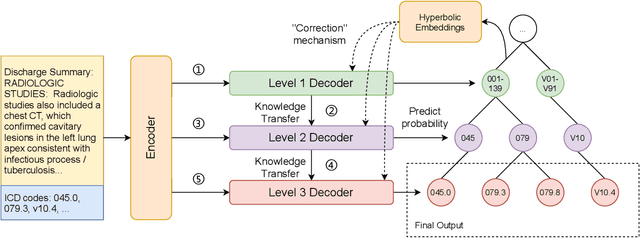
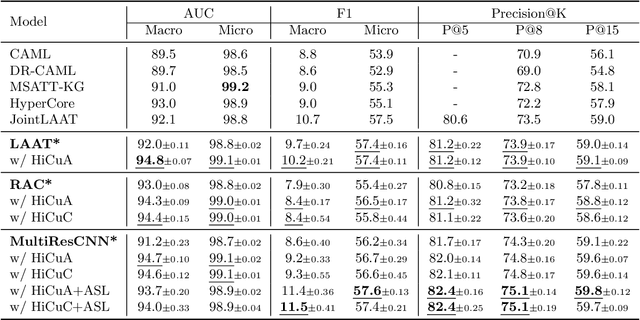


Abstract:There are several opportunities for automation in healthcare that can improve clinician throughput. One such example is assistive tools to document diagnosis codes when clinicians write notes. We study the automation of medical code prediction using curriculum learning, which is a training strategy for machine learning models that gradually increases the hardness of the learning tasks from easy to difficult. One of the challenges in curriculum learning is the design of curricula -- i.e., in the sequential design of tasks that gradually increase in difficulty. We propose Hierarchical Curriculum Learning (HiCu), an algorithm that uses graph structure in the space of outputs to design curricula for multi-label classification. We create curricula for multi-label classification models that predict ICD diagnosis and procedure codes from natural language descriptions of patients. By leveraging the hierarchy of ICD codes, which groups diagnosis codes based on various organ systems in the human body, we find that our proposed curricula improve the generalization of neural network-based predictive models across recurrent, convolutional, and transformer-based architectures. Our code is available at https://github.com/wren93/HiCu-ICD.
 Add to Chrome
Add to Chrome Add to Firefox
Add to Firefox Add to Edge
Add to Edge